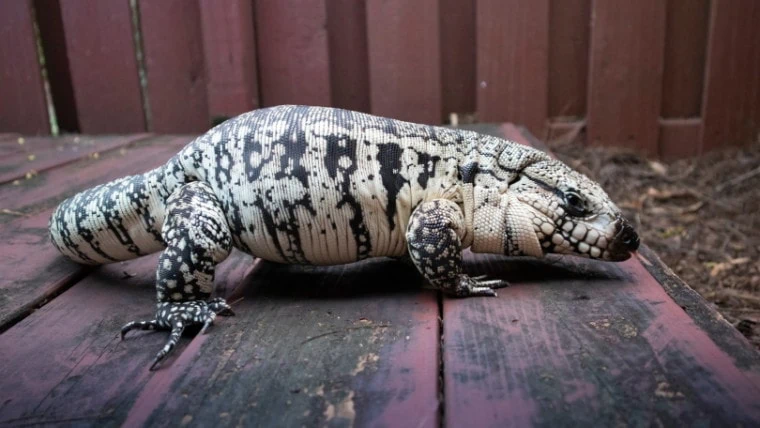
Description:
Scientific name: Salvator merianae
Life span: 10-15 years
Compared to other Tegu breeds, the Argentine Blue Tegu is smaller. Depending on their morph or genes, Blue Tegus can be any shade of blue, white, or black. Nonetheless, they typically appear like the Argentine Tegu, which is black and white. They have skin that is tough and covered in scales. The front foot of blue tegus have sharp claws that are utilized for digging and climbing trees. They also have strong arms. They are also tall and have slim physiques.
Native Region/Habitat
South America is the home of the blue Tegu lizard. They occupy woodlands near bodies of water, such as rivers and lakes, where they can find an abundance of insects to consume. Brazil, Paraguay, Argentina, and Uruguay are all home to them.

Behavior:
Blue Tegus are renowned for their wit, power, and kind demeanor. Yet, as a sign of maturity during their second year, Blue Tegu lizards may become hostile and destructive. You ought to be concerned about this conduct and keep a close bond with your pet. At this point, training will be crucial. Your Tegu will ultimately calm down and become more docile, even though the process can be a little challenging.
Moreover, blue tegus are renowned for their active and amusing dispositions. These playful reptiles love to cuddle on the couch, explore their surroundings, and play with toys.
Care As a pet/In captivity:
Tank:
A Blue Tegu matures to adult size at around age 5. It will require a tank that is at least 6 feet long and ideally 8 feet. It will have adequate room to manoeuvre as a result. The optimal living environment for keeping the proper humidity and temperature will be an aquarium. Given that your Tegu is a bit of an escape artist, it can also guarantee that it stays in its cage.
The walls must be cleaned on a daily basis to maintain a healthy environment for your pet. Also, dispose of rubbish right away. If necessary, switch out the substrate to keep odors under control.
Heating (Temperature & Humidity):
To mimic its natural habitat, the Blue Tegu prefers temperatures on the warm side. Heaters and lighting will be enough. To keep an eye on the temperature, we advise placing a thermometer inside the cage. Not to fall below 75 degrees F. A daily misting is a great approach to make sure the aquarium is sufficiently humid. A durable water bottle that you should replenish every day should also be included.
Because of this, they need extremely high humidity levels to flourish. Their environment should have a humidity level between 75% and 90%.
Feeding & Diet:
Being omnivores, Argentine Blue Tegus consume both meat and plants. If there are any available, they will consume fruits and vegetables like bananas or pumpkins but prefer to devour tiny rodents like mice or rats.
Tegu juveniles require more protein than adult tegus do, hence their food should be 90% protein and 10% produce. The recommended diet for adult or fully developed Blue Tegus is 60% protein, 30% veggies, and 10% fruit.
Table





